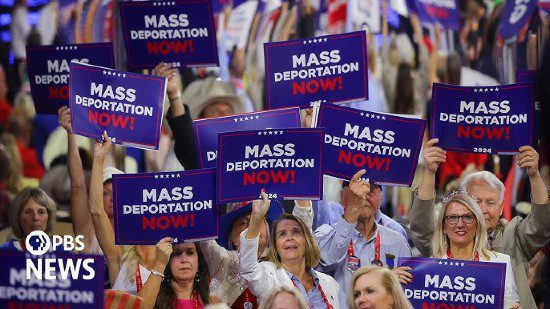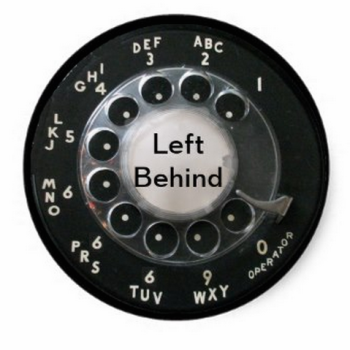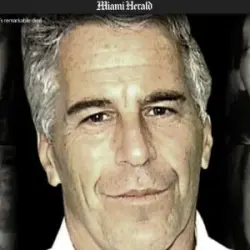While campaigning for the 2024 election, Donald Trump pledged that he would deport 20 million “illegal immigrants.” This claim got a lot of attention at the time because the high-end estimate for the total number of illegal immigrants was around 11 million people.
 That’s not 11 million people who snuck into the country illegally, mind you. To get that high a number you had to include pretty much every non-citizen residing in America who wasn’t 100% perfect with all of the paperwork, forms in triplicate, dozens of court-dates, employment records, etc., that legal immigrants struggled to complete as they jumped through all the hoops of our labyrinthine, chaotic, exhausting “proper channels.”
That’s not 11 million people who snuck into the country illegally, mind you. To get that high a number you had to include pretty much every non-citizen residing in America who wasn’t 100% perfect with all of the paperwork, forms in triplicate, dozens of court-dates, employment records, etc., that legal immigrants struggled to complete as they jumped through all the hoops of our labyrinthine, chaotic, exhausting “proper channels.”
So Trump wasn’t just promising to deport “illegal” aliens. He was promising to deport all of the legal immigrants who had anything less than a perfect paper trail.
And then another 9 million people on top of that.
Who would those 9 million people be?
Well, some of them, it turns out, are international students. These are people with visas — with legal permission granting them the ability to come and stay in America to study at our colleges and universities. They have a signed contract from the American government, essentially, saying they have asked for and received permission to be here. They are not “illegal immigrants” because there is nothing illegal about their presence and because they are not even immigrants — they’re just visiting here to study.
But hey, if you’re trying to get to the magic number of 20 million deportations, you’re going to have to include even these ultra-legal, non-immigrants with certified permission to be here. And you do that by retracting their permission to be here — revoking their visas.
When there aren’t enough “illegal immigrants” to deport 20 million of them, you make up the shortfall by creating new ones and declaring all legal immigrants to be, henceforth, “illegal.”
Part of the administration’s plan for the mass-deportation of international students involves using “social media vetting” as a pretext for revoking student visas. Hence, “State Department orders embassies to pause new student visa appointments as it moves to expand social media vetting.”
That’s from a week ago. Initially, this was just about Harvard and Trump’s obsessive war with that one university. But now it’s all of them. This is causing chaos for both students and universities, as no one is able to figure out whether or not international students will be able to enroll for the fall semester: “‘Time is of the essence’: Pause on international student visa interviews sends schools on another Trump-induced scramble.”
At Mount Holyoke College, a liberal arts school some 90 miles west of Boston, administrators have few answers so far for their prospective international students who are no longer certain they will be allowed to study in the US.
The Trump administration’s order directing US missions to pause new visa interviews for international students has thrust schools into a scramble to assess the impact on institutions and their students.
“This is supposed to be a celebratory time where they’re looking forward to coming to the United States, going here for their education, and suddenly, all of that’s, you know, been thrown up in the air,” said Kavita Khory, a professor of politics at Mount Holyoke and director of the school’s center for global initiatives.
The women’s college admitted 140 international students for the upcoming academic year, but only about 50 of those students have received their visas, Khory said. The majority are in limbo for appointments.
“And even if they have secured appointments, it’s not clear that they’ll get their visas,” Khory said.
Mount Holyoke’s situation is true for many colleges and universities. But with few answers, and amid heightened concerns about being critical of the Trump administration’s actions, few schools are willing to discuss it. CNN reached out to 50 schools and heard from fewer than 10 about how they are handling this period of uncertainty.
Schools are afraid to talk to reporters because they don’t want to attract President Abuse of Power’s attention. If he gets mad at them or if Stephen Miller gets mad at them, then the administration might do to them what it’s doing to Harvard — conducting an “investigation” of their “DEI” policies and trying to coerce them to fire all the women and non-white people like Al Mohler did at Southern Seminary 30 years ago.
Harvard has a huge endowment and an army of powerful alumni to fight back, but most colleges don’t, so they’re just keeping quiet, keeping their heads down, and trying to avoid eye contact.
A lot of the reporting on this has focused on the potential financial blow to universities — international students usually pay full tuition, but serving a global community of international students and having an international presence in the campus community is also an essential part of many school’s identity and mission.
This is particularly true for many religious schools, where having an international community with students from all over the globe is an expression of their deepest religious, doctrinal, and theological commitments. For a range of such colleges and universities — from Notre Dame to BYU to Liberty and Wheaton and Moody Bible Institute — including international students is an intrinsic aspect of their religious identity.
So this is a story with a huge religion angle and yet, for more than a week, I didn’t see any reporting on that. No comment or response from any of the religious universities impacted by this “Pause on international student visas.” And no reporting asking them for comment.
The first such article appeared yesterday, from Gina Christian, who writes for the Catholic OSV (Our Sunday Visitor) News, “Catholic universities look to support foreign students amid Trump visa crackdown.” Christian provides strong public comment from Notre Dame, Santa Clara, and, especially, Fordham — a Jesuit school founded in 1841 “to serve immigrants and their families.” (Fordham is also in the Bronx, so they know the guy they’re fighting against, and they’re not scared of him.)
That’s three Catholic schools willing to publicly support their international students. Unlike that CNN report, she doesn’t tell us how many schools she reached out to for comment, but I’m guessing it was more than three.
What about all of the white evangelical schools in the Council for Christian Colleges & Universities? The inclusion of international students is an essential expression of their ecclesiological and missiological beliefs, of the core of their religious faith. Are any of them willing to speak up for those students? Or to actually fight for them?
I wouldn’t bet on it. The CCCU makes a lot of noise about defending its “religious freedom” but as Trump and Rubio explicitly restrict that freedom, they seem content to sit back and take it. OK, then.
See also, Martin Longman on “What the Ban On International Students Is Really About.” This is not unprecedented, but it’s precedents are really, really bad.
And see also this: “A report published by four prominent Catholic and evangelical organizations claims that around 1 in 12 Christians in the U.S. are vulnerable to deportation or live with a family member who could be deported by President Donald Trump’s administration.” The Center for the Study of Global Christianity at Gordon-Conwell Theological Seminary helped produce that report back in April.












